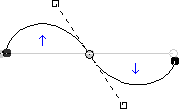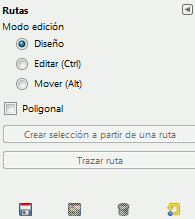The Paths tool allows to create complex selections called Bézier Curves, a bit like the Free Selection tool but with all the adaptability of vectorial curves. You can edit your curve, you can paint with your curve, or even save, import, and export the curve. You can also use paths to create geometrical figures. Paths have their own dialog box: Dialog.
See the Path concept.
There are different possibilities to activate the tool:
-
From the main menu: → .
-
By clicking the tool icon
in the Toolbox.
-
By pressing the B keyboard shortcut.
![[Nota]](images/note.png)
|
Nota |
|---|---|
|
Los mensajes de ayuda aparecen en la parte inferior de la ventana de la imagen para ayudarle sobre todas estas teclas. |
- Mayús
-
Esta tecla tiene distintas funciones dependiendo del contexto. Consulte las opciones para obtener más detalles.
- Ctrl; Alt
-
Hay tres modos disponibles para trabajar con la herramienta de rutas: Diseño, Editar y Mover. La tecla Ctrl alterna entre «diseño» y «editar». La tecla Alt (o Ctrl+Alt) para alternar entre «diseño» y «mover».
Normally, tool options are displayed in a window attached under the Toolbox as soon as you activate a tool. If they are not, you can access them from the main menu through → → which opens the option window of the selected tool.
- Modo edición
-
- Design
-
De manera predeterminada, esta herramienta está en modo Diseño. Puede dibujar la ruta con pulsaciones sucesivas. Puede mover los puntos de control pulsando sobre ellos y arrastrándolos. Entre los puntos de control están los segmentos.

Los números son los pasos para dibujar una ruta recta de dos segmentos.

Los segmentos curvos se pueden hacer fácilmente arrastrando un segmento o un nuevo nodo. Las flechas en azul indican la curva. Aparecen dos pequeñas anclas para que pueda arrastrarlas y así doblar el segmento.
![[Sugerencia]](images/tip.png)
Sugerencia To quickly close the curve, click on the initial control point. If you want to reposition the start node, hold Shift and click to deselect the end node, then move the start node.
You can use the button or
the Path to Selection button in the Paths dialog to convert the path to a Selection.
![[Sugerencia]](images/tip.png)
Sugerencia Cuando tiene dos anclas, trabajan simétricamente de manera predeterminada. Suelte el botón del ratón para moverlas individualmente. La tecla Mayús fuerza a las anclas a trabajar simétricamente de nuevo.
Several functions are available in Design mode:
Insertar un nodo nuevo: cuando pulsa Ctrl y sitúa el puntero del ratón sobre la ruta existente, el puntero del ratón cambia a un signo «+». Si pulsa se creará un nodo de ruta nuevo en ese punto de la ruta.
Mover uno o varios nodos: si se posiciona sobre un nodo, el puntero del ratón se convierte en una cruz de cuatro flechas. Puede pulsar y arrastrarlo. Puede seleccionar varios nodos con Mayús, pulsar y moverlos mediante pulsar y arrastrar. Pulsando Ctrl+Alt puede mover toda la ruta, como una selección.
Modifying handles: You have to Edit a node first. A handle appears. Drag it to bend the curve. Pressing Shift toggles to symmetric handles.
Modify segment: When the mouse pointer moves over a segment, it turns to a 4-arrows cross. Click and drag it to bend the segment. As soon as you move it, handles appear at both ends of the segment. Pressing the Shift key toggles to symmetric handles.
Añadir una subruta nueva: cuando pulsa Mayús y sitúa el puntero del ratón fuera de la ruta existente, el puntero del ratón comienza a mostrar un cuadrado. Si pulsa se iniciará una subruta que no está conectada a otras curvas pero se considera parte de la ruta.
- Edit (Ctrl)
-
Edit performs functions which are not available in Design mode. With this mode, you can work only on the existing path. When the mouse pointer is not on the path, the pointer changes to a small crossed circle and you can not do any path editing.
Añadir un segmento entre dos nodos: pulse sobre el nodo de una punta para activarlo. El puntero es como un símbolo de unión. Pulse sobre otro nodo para vincular ambos nodos. Esto es útil cuando tiene que vincular componentes abiertos.
Remove a segment from a path: While pressing Shift+Ctrl key combination, point to a segment. The mouse pointer turns to a "-" sign. Click to delete the segment.
Add a node to a path: point to a segment. Pointer turns to "+"". Click where you want to place the new control point.
Remove a node: While pressing Shift+Ctrl key combination, point to a node. Pointer turns to "-"". Click to delete the node.
Añadir un ancla a un nodo: señale un nodo. El puntero cambia a una pequeña mano. Arrastre el nodo para que aparezca el ancla. Presione Mayús para cambiar a anclas simétricas.
Remove a handle from a node: While pressing Shift+Ctrl key combination, point to a handle. The pointer doesn't turn to the expected "-"" and remains a hand. Click to delete the handle.
![[Atención]](images/caution.png)
Atención There is no warning before removing a node, segment or a handle.
- Move (Alt)
-
El modo Mover permite mover uno o todos los componentes de una ruta. Simplemente pulse sobre la ruta y arrástrela.
If you have several components, only the selected one is moved. If you click and drag outside the path, all components are moved. Pressing the Shift key toggles between moving all components and selected components only.
- Poligonal
-
Con esta opción, los segmentos son sólo rectos. No hay anclas y los segmentos no se doblan cuando se mueven.
- Selection from Path
-
This button allows creation of a selection that is based on the path in its present state. This selection is marked with the “marching ants” . Note that the path is still present: the current tool is still the path tool and you can modify this path without modifying the selection that has become independent. If you change tools, the path becomes invisible, but it persists in the Paths Dialog and you can re-activate it.
Si la ruta no está cerrada, GIMP une la selección con una línea recta.
As the help pop-up tells, pressing Shift when clicking on the button will add the new selection to an already existing one. Pressing Ctrl will subtract the selection from the pre-existing selection, and the Shift+Ctrl key combination will intersect the two selections.
- Fill path
-
This lets you fill an enclosed path with a solid color or pattern.
- Trazar ruta
When right-clicking on path elements, like anchors or segments, a context menu will appear, the contents of which depends on the item you clicked on. The following commands may be shown in the context menu.
- Delete Anchor
-
This command deletes the selected anchor and connects the segments before and after it.
- Shift Start
-
This command shifts the start anchor to the selected anchor. The start anchor is where stroking starts. The start anchor has a pointy side indicating the stroking direction. This can be useful when you want to wrap Text along Path.
Shifting the start anchor on open strokes may insert a new segment connecting the previous endpoints, and removes the segment leading into the new start anchor.
- Insert Anchor
-
This command adds a new anchor on the selected spot on the segment.
- Delete Segment
-
This command deletes the selected segment. This will create an opening in your path.
- Reverse Stroke
-
This reverses the direction of the stroke. The shape of the start anchor will reflect the direction of the stroke. The pointy side is the direction it will go to when stroking.




